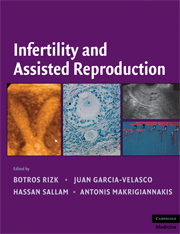Book contents
- Frontmatter
- Contents
- Contributors
- Foreword
- Preface
- Introduction
- PART I PHYSIOLOGY OF REPRODUCTION
- PART II INFERTILITY EVALUATION AND TREATMENT
- 6 Evaluation of the Infertile Female
- 7 Fertiloscopy
- 8 Microlaparoscopy
- 9 Pediatric and Adolescent Gynecologic Laparoscopy
- 10 Laparoscopic Tubal Anastomosis
- 11 Tubal Microsurgery versus Assisted Reproduction
- 12 The Future of Operative Laparoscopy for Infertility
- 13 Operative Hysteroscopy for Uterine Septum
- 14 Laser in Subfertility
- 15 Ultrasonography of the Endometrium for Infertility
- 16 Ultrasonography of the Cervix
- 17 Transrectal Ultrasonography in Male Infertility
- 18 The Basic Semen Analysis: Interpretation and Clinical Application
- 19 Evaluation of Sperm Damage: Beyond the WHO Criteria
- 20 Male Factor Infertility: State of the ART
- 21 Diagnosis and Treatment of Male Ejaculatory Dysfunction
- 22 Ovulation Induction
- 23 Clomiphene Citrate for Ovulation Induction
- 24 Aromatase Inhibitors for Assisted Reproduction
- 25 Pharmacodynamics and Pharmacokinetics of Gonadotrophins
- 26 The Future of Gonadotrophins: Is There Room for Improvement?
- 27 Ovarian Hyperstimulation Syndrome
- 28 Reducing the Risk of High-Order Multiple Pregnancy Due to Ovulation Induction
- 29 Hyperprolactinemia
- 30 Medical Management of Polycystic Ovary Syndrome
- 31 Surgical Management of Polycystic Ovary Syndrome
- 32 Endometriosis-Associated Infertility
- 33 Medical Management of Endometriosis
- 34 Reproductive Surgery for Endometriosis-Associated Infertility
- 35 Congenital Uterine Malformations and Reproduction
- 36 Unexplained Infertility
- 37 “Premature Ovarian Failure”: Characteristics, Diagnosis, and Management
- PART III ASSISTED REPRODUCTION
- PART IV ETHICAL DILEMMAS IN FERTILITY AND ASSISTED REPRODUCTION
- Index
- Plate section
- References
30 - Medical Management of Polycystic Ovary Syndrome
from PART II - INFERTILITY EVALUATION AND TREATMENT
Published online by Cambridge University Press: 04 August 2010
- Frontmatter
- Contents
- Contributors
- Foreword
- Preface
- Introduction
- PART I PHYSIOLOGY OF REPRODUCTION
- PART II INFERTILITY EVALUATION AND TREATMENT
- 6 Evaluation of the Infertile Female
- 7 Fertiloscopy
- 8 Microlaparoscopy
- 9 Pediatric and Adolescent Gynecologic Laparoscopy
- 10 Laparoscopic Tubal Anastomosis
- 11 Tubal Microsurgery versus Assisted Reproduction
- 12 The Future of Operative Laparoscopy for Infertility
- 13 Operative Hysteroscopy for Uterine Septum
- 14 Laser in Subfertility
- 15 Ultrasonography of the Endometrium for Infertility
- 16 Ultrasonography of the Cervix
- 17 Transrectal Ultrasonography in Male Infertility
- 18 The Basic Semen Analysis: Interpretation and Clinical Application
- 19 Evaluation of Sperm Damage: Beyond the WHO Criteria
- 20 Male Factor Infertility: State of the ART
- 21 Diagnosis and Treatment of Male Ejaculatory Dysfunction
- 22 Ovulation Induction
- 23 Clomiphene Citrate for Ovulation Induction
- 24 Aromatase Inhibitors for Assisted Reproduction
- 25 Pharmacodynamics and Pharmacokinetics of Gonadotrophins
- 26 The Future of Gonadotrophins: Is There Room for Improvement?
- 27 Ovarian Hyperstimulation Syndrome
- 28 Reducing the Risk of High-Order Multiple Pregnancy Due to Ovulation Induction
- 29 Hyperprolactinemia
- 30 Medical Management of Polycystic Ovary Syndrome
- 31 Surgical Management of Polycystic Ovary Syndrome
- 32 Endometriosis-Associated Infertility
- 33 Medical Management of Endometriosis
- 34 Reproductive Surgery for Endometriosis-Associated Infertility
- 35 Congenital Uterine Malformations and Reproduction
- 36 Unexplained Infertility
- 37 “Premature Ovarian Failure”: Characteristics, Diagnosis, and Management
- PART III ASSISTED REPRODUCTION
- PART IV ETHICAL DILEMMAS IN FERTILITY AND ASSISTED REPRODUCTION
- Index
- Plate section
- References
Summary
Polycystic ovary syndrome (PCOS) is the most common endocrine disorder in women. Its prevalence among infertile women is 15–20 percent. The etiology of PCOS remains unclear; however, several studies have suggested that PCOS is an X-linked dominant condition (1). The clinical manifestation of PCOS varies from a mild menstrual disorder to severe disturbance of reproductive and metabolic functions. Women with PCOS are predisposed to type 2 diabetes or develop cardiovascular disease (2).
DEFINITION OF PCOS
In a workshop sponsored by ESHRE (European Society for Human Reproduction and Embryology) and ASRM (American Society for Reproductive Medicine) in Rotterdam in 2003, a new definition of PCOS was proposed (3). This consensus defined PCOS as a syndrome with two out of three of the following features: oligo- or anovulation, clinical and/or biochemical sign of hyperandrogenism, and/or sonographic finding of polycystic ovaries (after exclusion of other etiologies such as congenital adrenal hyperplasia, androgen-secreting tumors, or Cushing's syndrome) (Table 30.1).
Sonographic features of polycystic ovaries (PCO) include the presence of twelve or more follicles in each ovary measuring 2–9 mm in diameter and/or increased ovarian volume (>10 mL). This is regardless of follicle distribution, ovarian stromal echogenicity, or ovarian volume. One ovary fulfilling this definition is sufficient to define PCO (2, 4). It is recognized that some women with sonographic findings of PCO may have regular cycles without clinical or biochemical signs of hyperandrogenism.
Keywords
- Type
- Chapter
- Information
- Infertility and Assisted Reproduction , pp. 286 - 293Publisher: Cambridge University PressPrint publication year: 2008



